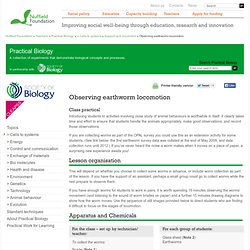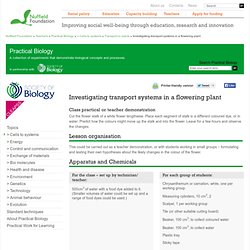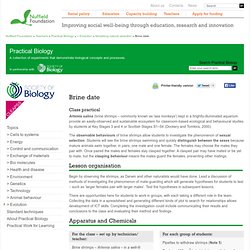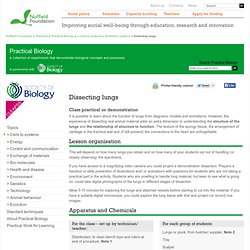

Observing earthworm locomotion. Introducing students to activities involving close study of animal behaviours is worthwhile in itself.

It clearly takes time and effort to ensure that students handle the animals appropriately, make good observations, and record those observations. If you are collecting worms as part of the OPAL survey you could use this as an extension activity for some students. (See link below: the first earthworm survey data was collated at the end of May 2009, and data collection runs until 2012.) If you’ve never heard the noise a worm makes when it moves on a piece of paper, a surprising new experience awaits you!
This will depend on whether you choose to collect some worms in advance, or include worm collection as part of the lesson. Video earthworm locomotion. Using a choice chamber to investigate animal responses to stimuli. These notes explain how a choice chamber is set up, and how to use one to provide adjacent environments with different environmental conditions.

You can then introduce small invertebrate organisms into the chamber, at different starting points, observe their movements, and record their distribution after a fixed time. Investigations using a choice chamber often depend on developing a null hypothesis with which the final result is compared. For example, a null hypothesis might state 'Woodlice show an equal preference for damp and dry areas in the choice chamber'. Video Choice Chamber. Vitamin C content of foods and fruit juices. Measure the vitamin C content of a sample of fruit juice by measuring the volume of the sample required to decolourise a solution of DCPIP.

Calibrate the results by comparison with a known concentration of vitamin C. Demonstrate the effect of vitamin C on DCPIP. Get students to test 2 or 3 of the juices you provide to practise the technique. Ask students to develop a hypothesis to test, and to investigate it systematically. Your classroom organisation may depend on the equipment you have available. The chemicals used in this investigation are LOW HAZARD (Notes 1 and 2). 1 Vitamin C solution: See CLEAPSS Hazcard. 2 DCPIP (2,6-dichlorophenol-indophenol) is LOW HAZARD; see CLEAPSS Hazcard. There are no ethical issues with this procedure. SAFETY: Take care with fragile glassware such as burettes.
Video Finding the vitamin C content of a food. Heart dissection. Video heart dissection. Transport systems in a flowering plant. Cut the flower stalk of a white flower lengthwise.

Place each segment of stalk in a different coloured dye, or in water. Predict how the colours might move up the stalk and into the flower. Leave for a few hours and observe the changes. This could be carried out as a teacher demonstration, or with students working in small groups – formulating and testing their own hypotheses about the likely changes in the colour of the flower. Chrysanthemum or carnation, white, one per working group. Measuring cylinders, 10 cm3, 2 Scalpel, 1 per working group Tile (or other suitable cutting board) Beaker, 100 cm3, to collect coloured water Beaker, 100 cm3, to collect water Plastic tray Sticky tape 500cm3 of water with a food dye added to it.
Carry scalpels in a tray when moving around the laboratory. Plant sap may be an irritant for some students. Food dyes are low hazard. 1 This experiment could also be set up in test tubes or boiling tubes, which could then be supported in a rack or a larger beaker. Preparation. Video of colour changing carnations. Brine date. Artemia salina (brine shrimps – commonly known as 'sea monkeys') kept in a brightly-illuminated aquarium provide an easily-observed and sustainable ecosystem for classroom-based ecological and behavioural studies by students at Key Stages 3 and 4 or Scottish Stages S1–S4 (Dockery and Tomkins, 2000).

The observable behaviours of brine shrimps allow students to investigate the phenomenon of sexual selection. Students will see the brine shrimps swimming and quickly distinguish between the sexes because mature animals swim together, in pairs, one male and one female. The females may choose the males they pair with. Once paired the males and females stay clasped together. A clasped pair may have mated or be yet to mate, but the clasping behaviour means the males guard the females, preventing other matings. Begin by observing the shrimps, as Darwin and other naturalists would have done. There are opportunities here for students to work in groups, with each taking a different role in the team. Video of brine shrimps. Dissecting lungs. It is possible to learn about the function of lungs from diagrams, models and animations.

However, the experience of dissecting real animal material adds an extra dimension to understanding the structure of the lungs and the relationship of structure to function. The texture of the spongy tissue, the arrangement of cartilage in the tracheal wall and (if still present) the connections to the heart are unforgettable. This will depend on how many lungs you obtain and on how many of your students opt out of handling (or closely observing) the specimens. If you have access to a magnifying video camera you could project a demonstration dissection.
Prepare a handout or slide presention of illustrations and/ or animations with questions for students who are not taking a practical part in the activity. Allow 5-10 minutes for exploring the lungs and attached vessels before starting to cut into the material. Lungs or pluck, from butcher/ supplier, Note 2 Tray Scalpel Dissecting scissors.
Video dissecting lungs. Photosynthesis. Test leaves for starch. Video test leaves for starch.